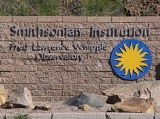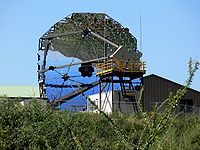
Fred Lawrence Whipple Observatory
Encyclopedia
The Fred Lawrence Whipple Observatory is an astronomical
observatory
owned and operated by the Smithsonian Astrophysical Observatory
(SAO) and is their largest field installation outside of their main site in Cambridge
, MA. It is located near Amado, Arizona
on the slopes of Mount Hopkins
.
Research activities include imaging and spectroscopy of extragalactic, stellar, and planetary bodies, as well as gamma-ray
and cosmic-ray
astronomy.
Formerly known as "The Mount Hopkins Observatory," the observatory was renamed in late 1981 in honor of Fred Lawrence Whipple
, noted planetary expert, space science pioneer, and director emeritus of SAO, under whose leadership the Arizona facility was established.
 Whipple observatory hosts the MMT Observatory
Whipple observatory hosts the MMT Observatory
, which is jointly run by SAO and the University of Arizona
and houses a 6.5-meter telescope. The observatory also has 1.5- and 1.2-meter reflectors and a second 1.3-meter reflector named PAIRITEL (Peters Automated IR Imaging Telescope, ex-2MASS ). Also on site is the HATNet (Hungarian-made Automated Telescope) network and the new MEarth project.
The observatory is known for its pioneering work in ground-based gamma-ray astronomy through the development of the Imaging Atmospheric Cherenkov
Technique (IACT) with the Whipple 10-meter Telescope during the early 1980s. The Whipple 10-meter is currently preparing to be decommissioned after forty years of service.
In April 2007, VERITAS
(a system of 4 IACT telescopes with 12-meter reflectors) started full operations at the FLWO basecamp. Subsequently, in September 2009, after a 4 month effort, one of the telescopes was moved to a new position, making the array symmetric and increasing its sensitivity.
Astronomy
Astronomy is a natural science that deals with the study of celestial objects and phenomena that originate outside the atmosphere of Earth...
observatory
Observatory
An observatory is a location used for observing terrestrial or celestial events. Astronomy, climatology/meteorology, geology, oceanography and volcanology are examples of disciplines for which observatories have been constructed...
owned and operated by the Smithsonian Astrophysical Observatory
Smithsonian Astrophysical Observatory
The Smithsonian Astrophysical Observatory is a research institute of the Smithsonian Institution headquartered in Cambridge, Massachusetts, where it is joined with the Harvard College Observatory to form the Harvard-Smithsonian Center for Astrophysics .-History:The SAO was founded in 1890 by...
(SAO) and is their largest field installation outside of their main site in Cambridge
Cambridge
The city of Cambridge is a university town and the administrative centre of the county of Cambridgeshire, England. It lies in East Anglia about north of London. Cambridge is at the heart of the high-technology centre known as Silicon Fen – a play on Silicon Valley and the fens surrounding the...
, MA. It is located near Amado, Arizona
Amado, Arizona
Amado is a census-designated place in Santa Cruz County, Arizona, United States. The population was 275 at the 2000 census.-Geography:Amado is located at ....
on the slopes of Mount Hopkins
Mount Hopkins (Arizona)
Mount Hopkins is a mountain in Santa Cruz County, Arizona part of the Santa Rita Mountains range. Fred Lawrence Whipple Observatory is located on it. It is within the Coronado National Forest and was named after Gilbert Hopkins who was killed nearby in 1865 during the Battle of Fort Buchanan....
.
Research activities include imaging and spectroscopy of extragalactic, stellar, and planetary bodies, as well as gamma-ray
Gamma ray
Gamma radiation, also known as gamma rays or hyphenated as gamma-rays and denoted as γ, is electromagnetic radiation of high frequency . Gamma rays are usually naturally produced on Earth by decay of high energy states in atomic nuclei...
and cosmic-ray
Cosmic ray
Cosmic rays are energetic charged subatomic particles, originating from outer space. They may produce secondary particles that penetrate the Earth's atmosphere and surface. The term ray is historical as cosmic rays were thought to be electromagnetic radiation...
astronomy.
History
In 1966, roadwork began on the current site with funding granted for the Smithsonian Mt. Hopkins Observatory. The Whipple 10-meter gamma-ray telescope was constructed in 1968.Formerly known as "The Mount Hopkins Observatory," the observatory was renamed in late 1981 in honor of Fred Lawrence Whipple
Fred Lawrence Whipple
Fred Lawrence Whipple was an American astronomer, who worked at the Harvard College Observatory for over 70 years...
, noted planetary expert, space science pioneer, and director emeritus of SAO, under whose leadership the Arizona facility was established.
Equipment

MMT Observatory
The MMT Observatory is an astronomical observatory on the site of Fred Lawrence Whipple Observatory . The Whipple observatory complex is located on Mount Hopkins, Arizona, USA in the Santa Rita Mountains...
, which is jointly run by SAO and the University of Arizona
University of Arizona
The University of Arizona is a land-grant and space-grant public institution of higher education and research located in Tucson, Arizona, United States. The University of Arizona was the first university in the state of Arizona, founded in 1885...
and houses a 6.5-meter telescope. The observatory also has 1.5- and 1.2-meter reflectors and a second 1.3-meter reflector named PAIRITEL (Peters Automated IR Imaging Telescope, ex-2MASS ). Also on site is the HATNet (Hungarian-made Automated Telescope) network and the new MEarth project.
The observatory is known for its pioneering work in ground-based gamma-ray astronomy through the development of the Imaging Atmospheric Cherenkov
Cherenkov radiation
Cherenkov radiation is electromagnetic radiation emitted when a charged particle passes through a dielectric medium at a speed greater than the phase velocity of light in that medium...
Technique (IACT) with the Whipple 10-meter Telescope during the early 1980s. The Whipple 10-meter is currently preparing to be decommissioned after forty years of service.
In April 2007, VERITAS
VERITAS
VERITAS is a major ground-based gamma-ray observatory with an array of four 12m optical reflectors for gamma-ray astronomy in the GeV - TeV energy range. The telescope design is based on the design of the existing 10m gamma-ray telescope of the Fred Lawrence Whipple Observatory...
(a system of 4 IACT telescopes with 12-meter reflectors) started full operations at the FLWO basecamp. Subsequently, in September 2009, after a 4 month effort, one of the telescopes was moved to a new position, making the array symmetric and increasing its sensitivity.

